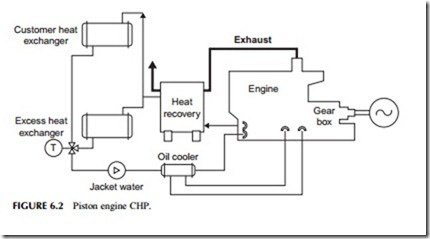PISTON ENGINES
There are two primary types of piston engine for power generation: the diesel engine and the spark-ignition gas engine. Of these the diesel engine is the most efficient, reaching close to 50% energy conversion efficiency. The spark- ignition engine burning natural gas can achieve perhaps 42% efficiency but it is much cleaner than the diesel. The level of emissions from an uncontrolled diesel engine are such that it is impossible to obtain authorization to use a diesel engine for continuous power generation service in some parts of the world unless it is fitted with an extensive emission control system. Natural gas engines can often operate with minimum emission control.
Piston engines are well suited to CHP applications where hot water is required because much of the energy that is not converted into electricity appears as heat at a temperature suitable for water heating. There are four sources of heat in a piston engine: the engine exhaust, engine jacket-cooling system, oil-cooling system, and turbocharger cooling system (if a turbocharger is fitted), as shown in Figure 6.2. Engine exhaust can provide low- to medium- pressure steam and the engine jacket-cooling system can provide low-pressure steam. However, for most piston engine CHP applications all the sources of heat
are used to generate hot water rather than steam. If all four sources of heat are exploited, roughly 70–80% of the energy in the fuel can be utilized.
Piston engine power plants suitable for general CHP applications are avail- able in sizes ranging from a few kilowatts to 6.5 MW. These engines are particularly good at load following; a spark-ignition engine efficiency falls around 10% at half load while diesel engine efficiency barely drops over this range. There is no significant penalty in terms of engine wear for variable-load operation either, unlike for some other engine types.
Applications for piston engine CHP plants include small offices and apartment blocks, hospitals, government installations, colleges, and small district heating systems. Engines tend to be noisy, so some form of noise insulation is normally required. Emissions of gas engines can normally be controlled with simple exhaust catalytic converter systems, but diesel engines usually require much more elaborate measures to control their higher nitrogen oxide and particulate emissions.
